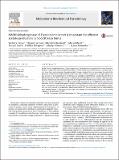NADH dehydrogenase of Trypanosoma brucei is important for efficient acetate production in bloodstream forms
Abstract
In the slender bloodstream form, Trypanosoma brucei mitochondria are repressed for many functions. Multiple components of mitochondrial complex I, NADH:ubiquinone oxidoreductase, are expressed in this stage, but electron transfer through complex I is not essential. Here we investigate the role of the parasite’s second NADH:ubiquinone oxidoreductase, NDH2, which is composed of a single subunit that also localizes to the mitochondrion. While inducible knockdown of NDH2 had a modest growth effect in bloodstream forms, NDH2 null mutants, as well as inducible knockdowns in a complex I deficient background, showed a greater reduction in growth. Altering the NAD+/NADH balance would affect numerous processes directly and indirectly, including acetate production. Indeed, loss of NDH2 led to reduced levels of acetate, which is required for several essential pathways in bloodstream form T. brucei and which may have contributed to the observed growth defect. In conclusion our study shows that NDH2 is important, but not essential, in proliferating bloodstream forms of T. brucei, arguing that the mitochondrial NAD+/NADH balance is important in this stage, even though the mitochondrion itself is not actively engaged in the generation of ATP.
Citation
Surve , S V , Jensen , B C , Heestand , M , Mazet , M , Smith , T K , Bringaud , F , Parsons , M & Schnaufer , A 2017 , ' NADH dehydrogenase of Trypanosoma brucei is important for efficient acetate production in bloodstream forms ' , Molecular and Biochemical Parasitology , vol. 211 , pp. 57-61 . https://doi.org/10.1016/j.molbiopara.2016.10.001
Publication
Molecular and Biochemical Parasitology
Status
Peer reviewed
ISSN
0166-6851Type
Journal article
Description
This work was supported by a grant from the National Institutes of Health (USA) [AI 5R01 AI069057] to MP and AS; a grant from the Medical Research Council (UK) [G0600129] to AS; grants from the Centre National de la Recherche Scientifique (CNRS, France), The Université de Bordeaux, The Agence Nationale de la Recherche (ANR) [ACETOTRYP of the ANR-BLANC-2010 call and GLYCONOV of the “Générique” call] and the Laboratoire d’Excellence (LabEx) ParaFrap [grant ANR-11-LABX-0024] to FB; and a grant from the Wellcome Trust [093228] to TKS.Collections
Items in the St Andrews Research Repository are protected by copyright, with all rights reserved, unless otherwise indicated.

